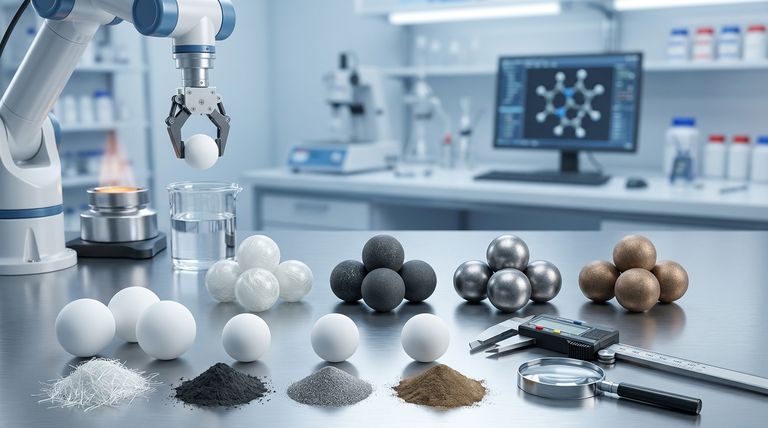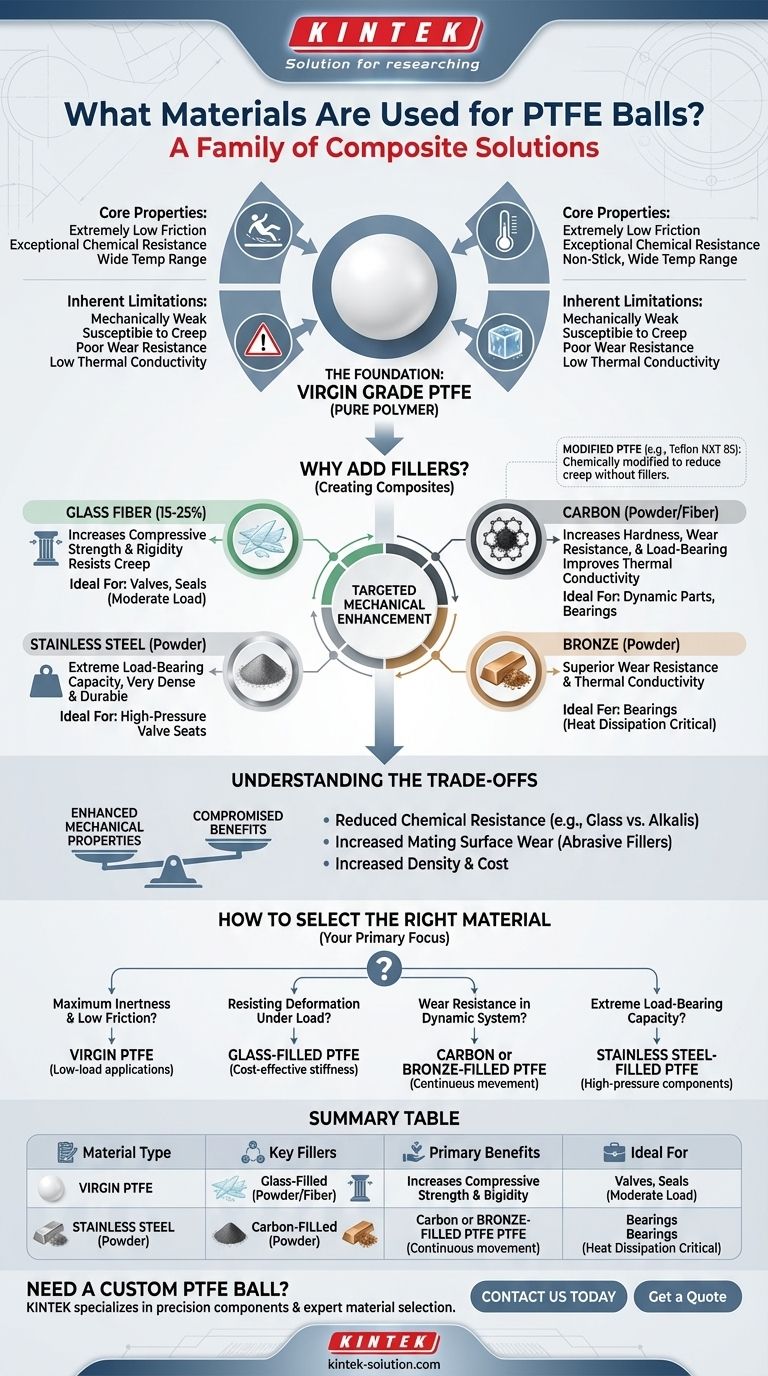The material used for a PTFE ball is not a single substance but rather a family of materials based on a core polymer. While all start with pure Polytetrafluoroethylene (PTFE), most high-performance applications use a composite, where fillers like glass, carbon, or stainless steel are added to the PTFE base to enhance specific physical properties.
The critical takeaway is not simply knowing what PTFE is, but understanding that its base properties—low friction and chemical inertness—are often balanced against its mechanical weaknesses. Fillers are used to overcome these weaknesses, creating specialized materials for specific applications like high-load valves or wear-resistant bearings.

The Foundation: Virgin Grade PTFE
What is Virgin PTFE?
Virgin PTFE is the pure, unadulterated polymer created from the polymerization of tetrafluoroethylene (TFE). It contains no fillers or recycled material. This is the baseline material from which all other grades are derived.
Its unique properties stem from the incredibly strong carbon-fluorine bonds in its molecular structure.
Core Properties of Virgin PTFE
Pure PTFE is renowned for a unique combination of characteristics:
- Extremely low coefficient of friction: It's one of the most slippery substances known.
- Exceptional chemical resistance: It is inert to almost all industrial chemicals and solvents.
- Non-stick surface: Materials do not readily adhere to it.
- Wide temperature range: It remains functional across a broad spectrum of temperatures.
Inherent Limitations
Despite its advantages, virgin PTFE is mechanically weak. It is relatively soft and susceptible to creep, which is the tendency to slowly deform under a constant load. It also has poor wear resistance and low thermal conductivity.
Why Add Fillers? Creating PTFE Composites
The Goal: Targeted Mechanical Enhancement
Fillers are added to PTFE to create a composite material that retains the desirable properties of PTFE while overcoming its mechanical limitations. The choice of filler is determined by the specific weakness you need to address in your application.
Common Fillers and Their Impact
Glass Fiber
Glass is the most common filler. Adding glass fibers (typically at 15% or 25% concentration) significantly increases compressive strength and rigidity. This makes glass-filled PTFE balls far more resistant to creep and deformation under load.
Carbon
Carbon, often in powder or fiber form, is added to increase hardness, wear resistance, and load-bearing strength. It also improves thermal conductivity, helping to dissipate heat in dynamic applications. A carbon-glass blend can offer a balanced set of enhancements.
Stainless Steel
For applications requiring maximum strength and load-bearing capability, stainless steel powder is used as a filler. A common formulation is a 50/50 blend by weight, creating a very dense and durable material ideal for high-pressure valve seats.
Bronze
Adding bronze powder improves wear resistance and thermal conductivity even more than carbon. Bronze-filled PTFE is excellent for bearings and other moving parts where heat dissipation is critical.
Modified PTFE
Some grades, like Teflon NXT 85, are not filled but are chemically modified at the polymer level. These modifications aim to reduce creep and improve durability without introducing a separate filler material, offering a different way to enhance mechanical properties.
Understanding the Trade-offs
The Cost of Enhancement
Adding fillers is not a free lunch. While you gain significant mechanical advantages, you often compromise some of virgin PTFE's original benefits.
Impact on Chemical Resistance
Fillers are generally not as chemically inert as pure PTFE. Glass-filled grades, for example, can be attacked by strong alkalis or hydrofluoric acid, compromising the universal chemical resistance of the component.
Changes in Friction and Wear
While fillers improve the wear resistance of the PTFE ball itself, abrasive fillers like glass can increase the wear on the mating surface it contacts. This is a critical consideration in system design.
Increased Density and Cost
Filled PTFE grades are denser, heavier, and typically more expensive than virgin PTFE due to the additional materials and manufacturing complexity.
How to Select the Right PTFE Ball Material
Your choice depends entirely on the primary demand of your application. Answering the "why" behind your need for a PTFE ball will lead you to the correct material.
- If your primary focus is maximum chemical inertness and low friction: Virgin PTFE is the definitive choice, provided mechanical loads and pressures are low.
- If your primary focus is resisting deformation under load (compressive strength): Glass-filled PTFE provides a significant and cost-effective improvement in stiffness.
- If your primary focus is wear resistance in a dynamic system: Carbon or bronze-filled grades are engineered for applications with continuous movement.
- If your primary focus is extreme load-bearing capacity: Stainless steel-filled PTFE offers the highest strength for high-pressure seats and structural components.
Ultimately, understanding that "PTFE" is a family of materials is the first step toward selecting the optimal component for your design.
Summary Table:
| Material Type | Key Fillers | Primary Benefits | Ideal For |
|---|---|---|---|
| Virgin PTFE | None (Pure Polymer) | Maximum chemical inertness, lowest friction | Low-load, high-purity chemical applications |
| Glass-Filled PTFE | Glass Fiber (15-25%) | High compressive strength, resists creep | Valves, seals under moderate load |
| Carbon-Filled PTFE | Carbon/Graphite | Excellent wear resistance, good thermal conductivity | Dynamic parts, bearings |
| Stainless Steel-Filled PTFE | Stainless Steel Powder | Extreme load-bearing capacity | High-pressure valve seats, structural components |
| Bronze-Filled PTFE | Bronze Powder | Superior wear resistance, high thermal conductivity | Bearings with heat dissipation needs |
Need a Custom PTFE Ball for Your Application?
Selecting the right PTFE material is critical for performance and longevity. KINTEK specializes in manufacturing precision PTFE components, including balls, seals, liners, and custom labware.
We serve the semiconductor, medical, laboratory, and industrial sectors with:
- Expert Material Selection: We help you choose between virgin PTFE and advanced composites (glass, carbon, steel, bronze) based on your needs for chemical resistance, load capacity, or wear resistance.
- Custom Fabrication: From prototypes to high-volume orders, we deliver components tailored to your specifications.
- Precision Production: Our processes ensure consistent quality and reliability for critical applications.
Contact us today to discuss your project requirements and get a quote: Reach out via our Contact Form
Visual Guide

Related Products
- Custom PTFE Teflon Balls for Advanced Industrial Applications
- Custom PTFE Parts Manufacturer for Teflon Parts and PTFE Tweezers
- Custom PTFE Parts Manufacturer for Teflon Containers and Components
- Custom PTFE Square Trays for Industrial and Laboratory Use
- Custom PTFE Measuring Cylinders for Advanced Scientific and Industrial Applications
People Also Ask
- What are the properties of Teflon balls? Unlock Elite Chemical & Friction Resistance
- What temperature range can PTFE balls withstand? Unlock Extreme Thermal Stability from -200°C to 260°C
- What are the common applications of PTFE balls? Leverage Unmatched Chemical Resistance & Low Friction
- What are the key features of Teflon balls? Unlock Superior Performance in Demanding Environments
- What size range do PTFE balls come in? A Guide from 3mm to 100mm



















